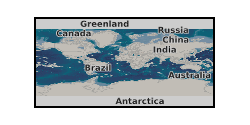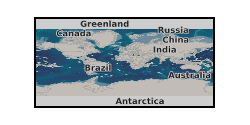Rheology
Type of resources
Topics
Keywords
Contact for the resource
Provided by
Years
Formats
Update frequencies
-

Synchrotron X-radiography (images) and diffraction data collected to measure rheology of Quartz coesite and stishovite.
-

Rheometric data for suspensions of bubbles and/or particles in a Newtonian suspending liquid. Experimental suspensions are intended as analogues for multiphase magma and lava (containing volatile bubbles and solid crystals). The dataset comprises data collected using a Anton Paar MCR702 rheometer. A Newtonian working fluid (sugar syrup) suspends variable fraction of gas bubbles and solid particles. Data relating to suspensions of bubbles only are found in the folder Bubble_Suspensions, and data relating to suspensions of bubbles and particles are found in the folder 3Phase_Suspensions. For all suspensions, rheometric data were collected in a wide-gap concentric cylinder geometry using both rotational rheometry (flow curves) and oscillatory rheometry (frequency sweeps). Bubble fraction and particle fraction are varied systematically. In each folder a matlab script is provided which facilitates extraction and analysis of the raw data, which are held in .csv files
-

Rheometry data on ash from Mt Meager, British Columbia, Canada. All measurements that generated these data were performed using an Anton Paar MCR302 rotational rheometer with an Anton Paar powder flow cell attached. The rotating measuring geometry is 24.16 mm in diameter and contains 20 evenly spaced depressions of 1.75 mm that extend the entire length of the measuring cylinder. The profiled nature of this geometry prevents particle slip during rotation. Shear rate sweeps were performed to characterise the rheological behaviour of our pyroclast-gas mixtures. ~50 g of sample (ash from Mt Meager, British Columbia, Canada) was loaded into the powder flow cell with the measuring geometry inserted. Then for a constant gas flux applied to the base of the powder flow cell, the measuring geometry was rotated to apply a range of shear rates starting at 0.1 s-1 ramping up to 328 s-1 with approximately 20 data points generated per decade. These shear rate sweeps were performed for monodisperse grain sizes from 500 µm to 63 µm at a range of volumetric gas flow rates. Specifically for the 500 µm sample the rheology experiments were performed at 0, 15, 30, 45, 50, 55, 60, 65, and 70 L min-1. For the 250 µm sample the rheology experiments were performed at 0, 15, 20, 25, 30, 35, and 40 L min-1. For the 125 µm sample the rheology experiments were performed at 0, 1, 2, 3, 4, 5, 7, 8, 9, and 10 L min-1. For the 63 µm sample the rheology experiments were performed at 0, 0.25, 0.5, 1, 1.5, 2, 3, 4, and 5 L min-1.
-

Synchrotron X-radiography (images) and diffraction data collected to measure rheology of olivine and ringwoodite structured Co2SiO4.
-

The data consists of a spreadsheet containing rheology data for 39 samples of syrup, containing air bubbles and/or spherical glass particles. These data were used by Truby et al. (2014) to support a model for the rheology of a three-phase suspension. Each sample was placed in the rheometer (concentric cylinder geometry), and the stress was stepped up and then down, taking a measurement of strain rate at each step. Further details of the experiments may be found in Truby et al. (2014). NERC grant is NE/K500999/1. Co-author working with a NERC grant, NE/G014426/1.
-

These datasets are for samples collected from Volcan de Colima (Mexico) which is at coordinates: 19°30’46" N 103°37’02" W / 19.512727°N 103.617241°W. This volcano erupts magmas that are crystal-bearing, making those cooled volcanic rocks ideal for experimentation. And so samples were cored from blocks from that volcano and those cores were then returned to high temperatures (up to 1000 C) and then deformed under controlled stresses. These data form the central part of this publication: https://doi.org/10.1016/j.jvolgeores.2024.108198. The deformation experiments were performed at LMU (Munich, Germany). The volcano coordinates from which the samples were collected are given above. The samples were deformed in a high temperature hydraulic press equipped with acoustic emission sensors. This is the ideal device for determining the behaviour of the magmas from Volcan de Colima under the same stresses and temperatures at which they were erupted. The data give key clues as to the modes of flow behaviour of the magma in volcanoes. This work provides generalised insights into magma flow behaviour.
-

Scanned and annotated thin sections, in plane-polarised and cross-polarised light. Derivative statistical data for mineral grainsize and spatial distribution.
-

This dataset contains high-speed video recordings and particle image velocimetry (PIV) analysis results from granular flow experiments performed on an inclined flume with a fixed rough substrate, at the University of Edinburgh. Included are the high-speed videos (.mp4), a Word document outlining the experimental details and analysis methods, and figures displaying key analytical results of vertical velocity and granular temperature profiles. The flows consist of sand particles with a volumetric mean diameter of 875 µm, propagating over a substrate of coarser sand with a mean diameter of 1063 µm. Experimental conditions include varying slope angles (34°–42°) to investigate the influence of inclination on flow dynamics. PIV was used to analyse the videos, generating vertical velocity profiles and granular temperature profiles. Lens distortion was corrected using MATLAB to ensure accurate measurements. This dataset is relevant to those interested in granular flow dynamics, natural hazard modelling (e.g., landslides, pyroclastic density currents), and granular flow industrial applications.
-

MFIX (Multiphase Flow with Interphase eXchanges) simulation input files and raw particle output files. The study was published in Breard, E. C., Fullard, L., & Dufek, J. (2024). Rheology of granular mixtures with varying size, density, particle friction, and flow geometry. Physical Review Fluids, 9(5), 054303. Description of files 1. Input particle input file (*.dat) 2. VELOCITY* and FORCES* files exported at 10 Hz The simulation are all done as pressure-controlled shear cells where the x and z axes are periodic boundaries, and the top and bottom boundaries are solid rough plates. The simulations are split in three types: MONODISPERSE, BIDISPERSE and TRIDISPERSE, where particle size (in mm), is indicated in the naming of the directory. The, in each set of simulation, the naming is with the following structure: 20N_0.0001ms, where the first number indicates the confining pressure (20 Newtons) and the second indicate the top plate moving velocity in the x-direction (0.0001 m/s). Note the simulations were run with MFIX-18. The MFIX code that is modified from the core code from the Department of Energy (DOE) is all present. The missing core code can be downloaded from the DOE department https://mfix.netl.doe.gov/.
-
Spatial and temporal datasets for shear-thinning and Newtonian small-scale analogue dyke experiments

These data consist of spatial and temporal datasets for 7 different small-scale laboratory experiments of fluid-driven fractures, described in the paper The hidden internal flow dynamics of shear-thinning magma in dikes (Kavanagh et al., 2025, accepted in AGU Advances, March 2025). These experiments, conducted at the University of Liverpool, are analogue models of magma transport via flux-driven dykes. The 7 experiments are named HEC1, HEC2, HEC3, XG1, XG2, W1, W2. Experiments HEC and XG involved the injection of a shear-thinning fluid (a hydroxyethyl cellulose polymer (HEC) and xanthan gum solution (XG)), whilst experiments W1 and W2 involved Newtonian water injections. Experiments HEC1, HEC3, XG1 and W1 were ‘seeded fluid experiments’ or ‘PIV experiments’, whilst experiments HEC2, XG2 and W2 were ‘seeded gelatine experiments’ or ‘dyke-thickness experiments’. We provide the raw experimental data along with the Matlab scripts used to process and plot the data. Further information is provided in the containing README documents.
 NERC Data Catalogue Service
NERC Data Catalogue Service